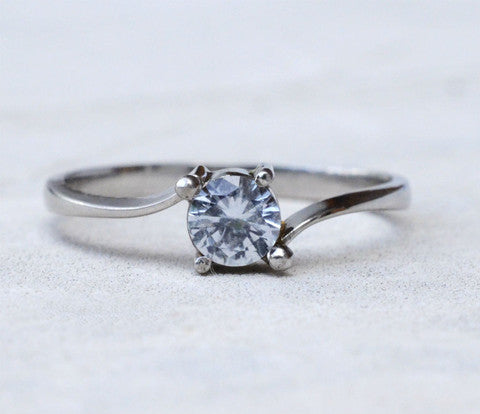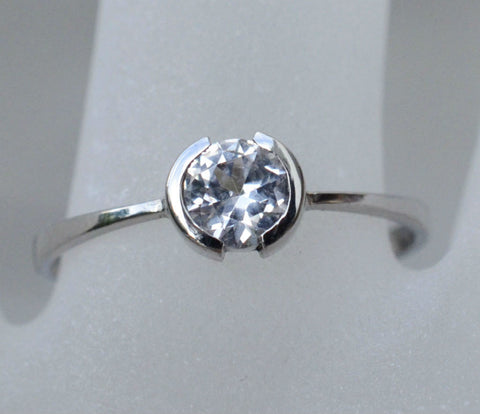Sapphire Jewelry and Sri Lanka (Ceylon)
Sapphires From Serendip May 15 2016
At Elizabeth Jewellers, we take great pride in sourcing all our natural sapphires from the beautiful island nation of Sri Lanka. Serendip, as it was known earlier in an ancient era, described it magnificently as an island of fortuitous coincidence. The origination of the word, Serendip, dates back to a Persian folk tale which follows the adventures of three princes who discover pleasant surprises and mystical treasures during their travels across the world.
Sri Lanka has enjoyed a reputation for possessing the world’s finest precious gemstones including some of the most exquisite sapphires known to man. These fine Ceylon sapphires feature brilliant colors, precise cuts and immaculate clarity that are destined to be adorned across the globe. So, if you, like the ancient Persian princes, do serendipitously discover us during your journey through the inter-webs, feel free to browse through our exclusive sapphire collections at www.elizabethjewellers.com.
Featured below is one of our favorite sapphire eternity rings! Alternating yellow sapphires and diamonds are paved in a stunning 18K white gold setting that perfectly suit an outing where you just want to feel special and elegant. You can view a full 360-degree view of this ring here or you can hop it on to your cart directly from our product page here. Feel free to contact us at any time and we’ll be glad to help you with your choice of sapphire!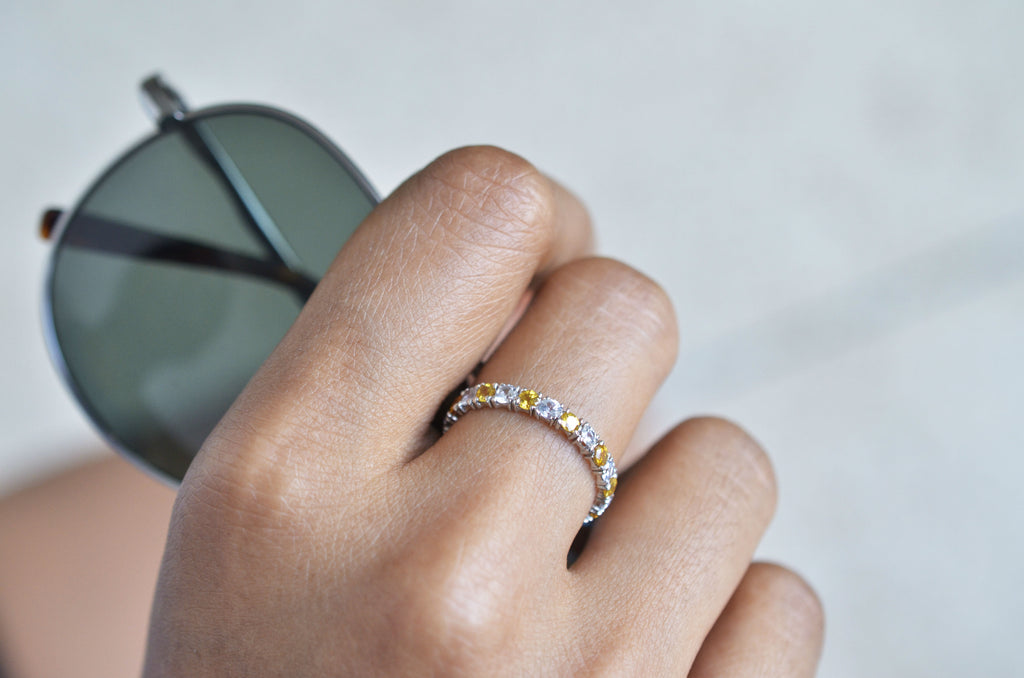
Why Should I Choose A Sapphire? May 15 2016
Sapphires have become the top choice of colored gemstones for modern brides. Whether it be a proposal in the sandy shores of the Maldives or a wedding in Westminster Abbey, contemporary couples are now opting for deep blue, lush yellow and even poignant pink sapphires for their choice of ring. They offer an opportunity to express a love that is distinct and personal. So, here are a couple of reasons why sapphires are now reigning supreme in the landscape of love.
Sapphires Are A Unique Expression
Sapphires are as distinct from each other as is the compassion, care and charisma of your significant other. Differences in shade enable each sapphire to present a one-of-a-kind appearance despite being the same color. As a result, you will be ensured a truly unique ring that embodies the one-of-a-kind love you share with your partner. What’s more is that each sapphire can be cut to any shape you require and they can be uniquely proportioned to maximize the brilliance and visual ‘oomph’.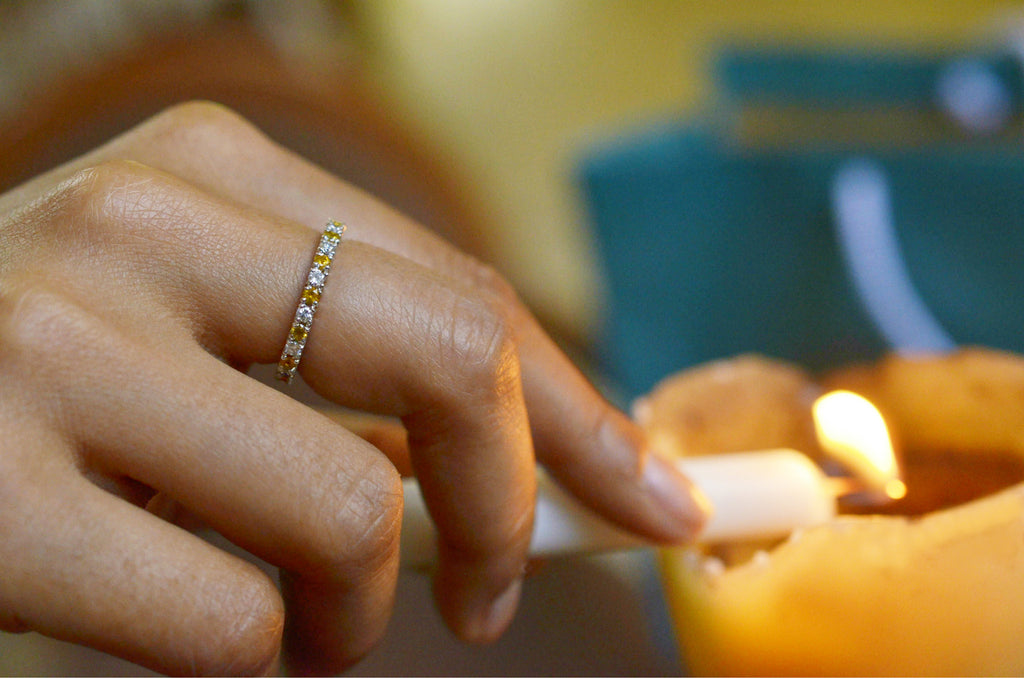
Yes, Sapphires Are Rarer & More Affordable Than Diamonds!
Unfortunately, the exorbitant prices of most diamonds is not attributed to an apparent rarity. Instead, it relies on the market manipulation of monopolies such as De Beers and aggressive marketing campaigns like ‘A Diamonds Is Forever’. Sapphires are much more geographically dispersed and are often found in incredibly thin supply. This makes it very difficult for the formation of market monopolies and enables small traders to reach equilibrium prices at a level far lower than diamonds. Fortunately, this bonds rarity and affordability together to create a true gem for couples across the world that meet their budget and expectations!
Sapphires Are Sustainable
Communities involved in mining for sapphires are often small and localized. Policies set in place by governments, especially in Sri Lanka, enable equitable wealth distribution among these small holders and retailers. Furthermore, automated mechanical processes are often banned to limit environmental damage and strict regulations are imposed on licenses to operate so that the level of mining does not harm the local environment nor the livelihoods of the people. Centuries of enhanced policy making has made this industry incredibly equitable and sustainable for the stakeholders involved from the landowners to the retail end jewelers. As a result, sapphires are becoming the increasingly ethical choice for clients from around the world.
Sapphires Are Becoming Increasingly Valuable
The demand for sapphires has seen a rapid upsurge as more eyes turn to the choice of sapphires made by celebrities and consumers learn about the value of natural sapphire gemstones. The auction prices for many flawless sapphires is a great indicator for this trend. The Star of Adam, for example, is likely to reach over $300 million as is many other brilliant natural sapphires from Sri Lanka.
At Elizabeth Jewellers, we want you to be yourself. It is your unique expressions of love, care and compassion that make this world a better place. Go out and make a difference and leave us the honor of making you a unique sapphire ring destined to suit your strength and beauty. Feel free to contact us directly at elizabethjewellers@gmail.com and let us know what you think about sapphires and how we can serve you better.
The Sapphire Traditions May 13 2016
With time, a bit of fortune and concerted effort, the special relationship you have with your best friend transforms into an eternal love that intertwine your hearts. You’ve decided to tread the paths of life together and commensurate this bond with an engagement. A component of this long lived tradition is, of course, the beautiful sapphire ring that sparkles in the eye of your partner and beckons the love filled life awaiting you. How did this tradition begin? What brought out these intricate and sacred practices?
Engagement rings were first used by in the Medieval Era by the Romans to embody the honorable intentions of the eager groom. In 1215, Pope Innocent III, mandated a waiting period from engagement to marriage to create the tradition we know today. It was said that sapphire engagement rings were used at the time as a test to identify the purity and honesty of each partner. The sapphire would change color if a case of infidelity were to be uncovered during this ‘engagement’ period but since natural sapphires rarely change color permanently, many blessed couples were wed in a blissful state. This link between sapphires and loyalty was buttressed by an 18th century novel, ‘Le Sapphire Merviellence’ written by Mme de Jenlis. His inspiration was derived from the color changing sapphire and it helped support a long lived tradition for sapphire engagement rings from couples across the world.
 In the early 19th century, the Victorians created another intricate and beautiful tradition held today among many engagements. They used brilliant yellow and rose gold engagement rings to house an assortment of precious gemstones that spelled ‘love’ (Lapis Lazuli, Opal, Vermarine & Emerald), ‘dearest’ (Diamond, Emerald, Amethyst, Ruby, Emerald, Sapphire & Topaz) or even the name of their beloved partner. These traditions marked distinct ways in which the lovers of past used to express their compassion and affection. The romance of the past still exists today and continue to be used in celebrating the love we have for our partners.
In the early 19th century, the Victorians created another intricate and beautiful tradition held today among many engagements. They used brilliant yellow and rose gold engagement rings to house an assortment of precious gemstones that spelled ‘love’ (Lapis Lazuli, Opal, Vermarine & Emerald), ‘dearest’ (Diamond, Emerald, Amethyst, Ruby, Emerald, Sapphire & Topaz) or even the name of their beloved partner. These traditions marked distinct ways in which the lovers of past used to express their compassion and affection. The romance of the past still exists today and continue to be used in celebrating the love we have for our partners.
At Elizabeth Jewellers we can help you design and make the perfect engagement ring for your better half to express your eternal love. You can reach us with all your questions and ideas at elizabethjewellers@gmail.com
Lesedi la Rona: Our Light May 08 2016
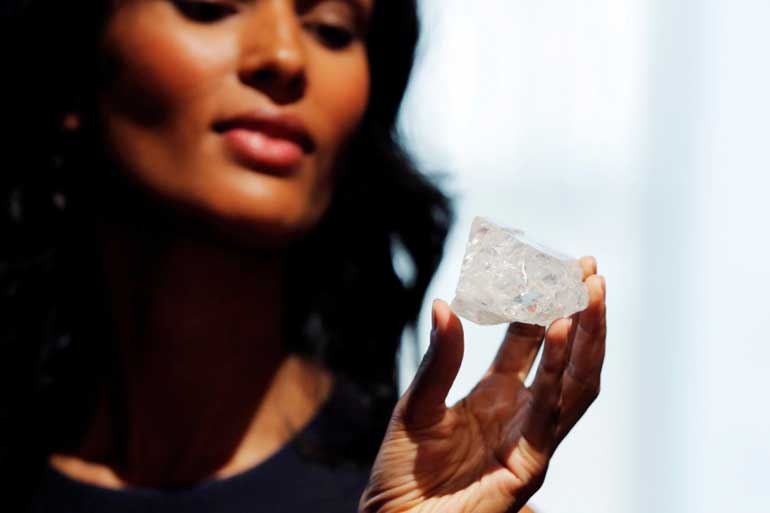
Beneath the bright city lights of New York City, lies yet another wonder of Mother Nature’s stunning creations, the ‘Lesedi la Rona’. A 1,190 carat diamond rough sits quaintly in a high security display at Sotheby’s as it awaits to be auctioned in London as the world’s largest gem quality diamond to be discovered in a century.
Found in Botswana just last year, the ‘Lesedi la Rona’ translates to ‘Our Light’ as it encompasses the sheer magnificence, awe and pride it brought to the Tswana people. At the size of tennis ball, this diamond is second only to the 3,000 carat Cullinan Diamond unearthed in South Africa in 1905. According to the Gemological Institute of America, the ‘Lesedi la Rona’ is over 3 billion years old and belongs to a special category known as ‘Type IIa Diamonds’ which exhibit exceptional clarity and color.
The origination of diamonds has often been a topic of controversy and damaged reputations. The illicit trade of ‘Blood Diamonds’ involve rebel forces in war-torn areas in the heart of Africa using forced labor to mine diamonds which will eventually finance their supply of arms and ammunition. However, the reforms and international support that has inundated many African nations such as Sierra Leone have helped curb the proliferation of this inhumanity. The United Nations, in particular, has been instrumental in implementing the Kimberly Process Certification System which has been incredibly successful in hindering the trafficking of illegally sourced diamonds from nations burdened with civil wars.
The trade of diamonds is becoming increasingly aware of its impacts on society. The human factor is one that can no longer be ignored and we have taken long strides in progressing sustainably and ethically. The ‘Lesedi la Rona’ shines its light not only on the glamor of jewelry but also on the hopes and lives of the people that strive to make this world better through acts of compassion and care.
Diamonds Got You Down? May 07 2016
You’ve browsed through countless websites, Pinterest highlights and Instagram features to finally find that perfect ring; featured in 18K white gold, sourced sustainably and beautifully presented in a halo array of diamonds. As you bask in its glimmer around your finger, you’re interrupted by the rude reality of how much it will set you back. Heart-broken, angered and disappointed, you cast it away and carry on in another endless journey through coveted collections with no real hope of what you will come across. The journey, the hunt, the longing, the whatever-you-call-it for jewelry, especially ones that feature diamonds, can be arduous at best. Fortunately, today and many generations before, a stunning and seductively alluring alternative awaits: white sapphires.
Despite the literary delineation, white sapphires are not white. They are in fact, natural, rare and precious gemstones which are as glimmering and transparent as their popular peer: the diamond. The absence of natural trace elements which grant color to many other sapphires such as the iron in deep blue sapphires and chromium in pink padparadschas is what creates the stunning transparency of white sapphires.
Once they are hand-picked for their natural elegance and faceted to a uniquely brilliant cut, these white sapphires will quickly captivate anyone who is privileged to see its shimmering shine. Often referred to as Nature’s blank canvas, these white sapphires set the scene to embody the love and friendship they are chosen to represent with the added perk of not straining well-earned wallets and purses. Its versatility as a natural gemstone puts it as the best alternative to many jewelry pieces chosen with diamonds as it always presents a strikingly similar clarity and glimmer at a fraction of the cost.
At Elizabeth Jewellers, the choice is entirely yours! All our jewelry can be customized to feature either diamonds or natural white sapphires so that you can wear your favorite ring, pedant or bracelet at a price that can fit your budget. We are always happy to guide you through this beautiful journey so feel free to contact us at any time.
Of Kings and Angels April 27 2016

Buddhism was introduced to Sri Lanka in 236 BCE or 236 years before Jesus Christ through a mission sent by King Ashoka from India.
Sri Lanka was officially called "Ceylon" during 1948–1972 under British colonial rule.
Most of the beautiful and priceless jewelry and artifacts found in Sri Lanka belong to the golden era of 'Anuradhapura'. The Kingdom of 'Anuradhapura' in Sri Lanka was established in 380 BCE during the reign of King Pandukabaya. Thereafter, 'Anuradhapura' served as the capital city of the country for nearly 1,400 years.

The above picture depicts the arm of the solid gold royal throne of the last king of Sri Lanka. This unique and priceless throne was returned by the British and is now displayed in the National Museum of Colombo - Sri Lanka.
This arm of throne is designed in a form of a standing lion with a gaping month. The lion's eye shown in the picture above is studded with a natural purple Amethyst gemstone.

This golden sword with a dragon shaped hilt studded with natural Ceylon gemstones displayed in the Colombo National Museum was worn by ancient kings in Sri Lanka during special occasions.
Innovating Past Traditions April 24 2016
Sri Lanka has historically been a believer of tradition. It is therefore no surprise that the gem faceting industry is almost as old as the gem mining industry. A gemstone attains its beauty and value only once it is polished and faceted and until the early 1970s much of it was executed through traditional artistry and inherited skill.
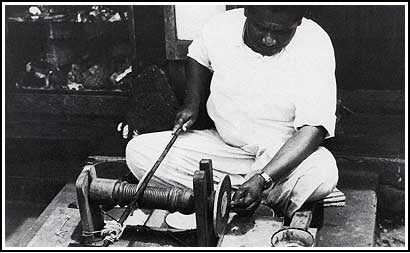 The ‘Hanaporuwa’ was the traditional tool to cut and polish many of the sapphires and diamonds found in the rivers and foothills of Sri Lanka. It utilized a bow and a steady hand to spin a flywheel that could be used to carefully shape a gemstone into an individual hand crafted masterpiece. However, as globalization grew and access to international markets flourished, the demand for perfectly cut and polished gems outgrew the performance inefficiency and lead times of an ancient art.
The ‘Hanaporuwa’ was the traditional tool to cut and polish many of the sapphires and diamonds found in the rivers and foothills of Sri Lanka. It utilized a bow and a steady hand to spin a flywheel that could be used to carefully shape a gemstone into an individual hand crafted masterpiece. However, as globalization grew and access to international markets flourished, the demand for perfectly cut and polished gems outgrew the performance inefficiency and lead times of an ancient art.
As a result, the industry evolved with the advent of technology to enhance precision and performance. Widespread adoption of advanced computer assisted faceting machinery enabled Sri Lanka to generate a ‘cut above the rest’ and hence gained global recognition in precision free size and calibrated cutting of diamonds and colored gemstones. Soon, the likes of Cartier and Rolex were employing the rapidly growing industry to generate cuts as small as 1/3rd of a millimeter with little to no tolerance for error in an assortment of their signature pieces.
Today, the gem faceting industry directly employs over 20,000 cutters throughout the island nation and over 5,000 of them are dedicated to diamonds or precious gemstones. As the influx of these natural gemstones grew, policies intended to preserve the sustainability of the industry were also set in place. Sri Lanka, along with 41 other nations, have agreed to ratify the Kimberly Process Agreement which enforced legislation that prohibited the trade of conflict diamonds that would be used to finance weapons and warfare in conflict areas.
The advent of technology and the willingness of the gem faceting industry to embrace it has aided the growth and well-being of many cutters, policy makers and retailers in Sri Lanka. This advancement remains to be a poster child for many other industries in this developing nation as it highlights the importance of respecting innovation and change over outdated traditions.
Jewelry At Your Fingertips: The Online Revolution April 17 2016

Rui Lin just got off work at her retail banking job in Shanghai and immediately jumped into her mobile phone to purchase an e ticket for the train ride back home. As a 32-year-old working mom, she laid back and relaxed for a few minutes on the coach as she glared past the rails and scenery whiz past her at 200 miles per hour. A few minutes in, her phone buzzed yet again and she surfing on the inter webs for an elegant beaded and lace gown for her wedding anniversary next week. Mrs. Lin is another example of how online retailing has taken over the world. Whether you’re in China or Brazil, the explosive growth of e-commerce has an astounding impact in revolutionizing the way you purchasing your favorite brand.
In 2016, the e-commerce market is expected to surpass $1.9 trillion. Exponential growth rates are forecasted for the next few decades as consumers everywhere gain access to the internet through personal mobile phones and computers. The rapid rise of connectivity in emerging nations in India and many other emerging economies fuel this growth at an astounding pace and will reshape the way business is done throughout the globe.
Despite impressive growth rates and a large consensus of the move toward online retailing, there has been one particular sector that has been slow to pick up the pace: fine jewelry. In the US alone, the jewelry market is over $70 billion and it is continually disrupted by the emergence of online extensions from big time players such as Swarovski and Blue Nile. So then why is the industry still playing catch up? Well, choosing a diamond encrusted engagement ring or a blue sapphire bracelet for a wedding anniversary is an incredibly emotionally charged purchase. Experts claim that clients want to personally experience jewelry before committing to purchase them. However, it’s not all doom and gloom. A new wave of technological innovations is making its way to the forefront of online jewelry to evolve the way this highly personal experience is preserved.
One particular improvement lies in the realm or concierge jewelry or in other words, personal jewelers. This sector usually runs as a smaller operation than retail jewelers and rely heavily on spread of word of mouth among their loyal clients. Their highly personalized service capabilities usually give them a distinct advantage but with the rise of ecommerce this style is becoming more prevalent. Online stores can be engineered to suit the needs of individual clients across a large base and hence improve the overall level of customer satisfaction.
Much of this enhanced engineering comes from the customizability of the jewelry offered. A survey conducted by Bain & Co. revealed that over 25% of clients are interested in online customization. This involves changing the orientation and carats of gemstones in jewelry, adjusting the alloy mix of metals utilized in rings, submitting their own CAD designs of personal jewelry and even selecting the mode of delivery to cater special occasions.
Better service through online retailing come also in the form of sophisticated websites. Seamless navigations, high quality images and videos of entire collections and intuitive check out processes enabled by secure payment gateways are all ways in which the e commerce has been taking over the jewelry industry. An exciting innovation to be realized very soon awaits in capabilities of 3D printing. As it becomes more common and costs fall, clients will be able to try out their own samples of jewelry and judge its comfort, fit and desirability well before they commit to the purchase.
The changing landscape of online shopping is becoming very important in shaping the new behaviors of consumers worldwide. Retailers are scrambling to ride the wave as an increasing margin of their sales are now being derived from their online stores. Technology is being used to marry personalized services to this new realm of e-commerce and the jewelry industry is at its forefront. So as Mrs. Lin surfs through her mobile to find that perfect dress, her actions are fueling a rapid advancement in society to make goods and services from around the world available at her fingertips.
Sinhala & Tamil New Year April 03 2016

Beneath the shades of a mango tree, lying coolly in the gentle breeze of the morning sun is the Koha (the Asian Koel) that lets out its reminiscent mating call, “Koo-ooo”. Yes, it is that time of year again, the Sinhala and Tamil New Year. ‘Aluth Avurudhu’ as it is known to the locals, plays a significant role in embracing the rich culture and religious history of this beautiful island nation and is always a festive time for recalibrating our senses and getting ready to push forward to another prosperous New Year.
As a country with a surprisingly long list of public holidays, one can easily wonder how anyone gets anything done but, the advent of ‘Avurudhu’ keeps everyone from school children to bank officials busy by preparing for a near week long holiday. The exact timing of the New Year isn’t as precise and reliable as the chime of the clock at midnight on the 31st. Instead, it relies on mysterious astrological interpretations which follow the movement of the sun from the Meena Rashiya (house of Pisces) to Mesha Rashiya (house of Aries). For the rest of us, this translates to a time generally between April 13 and April 14th. It also reflects the end of the harvest period by which the agrarian economy begins preparations to reap the benefits of their dedication to the land.
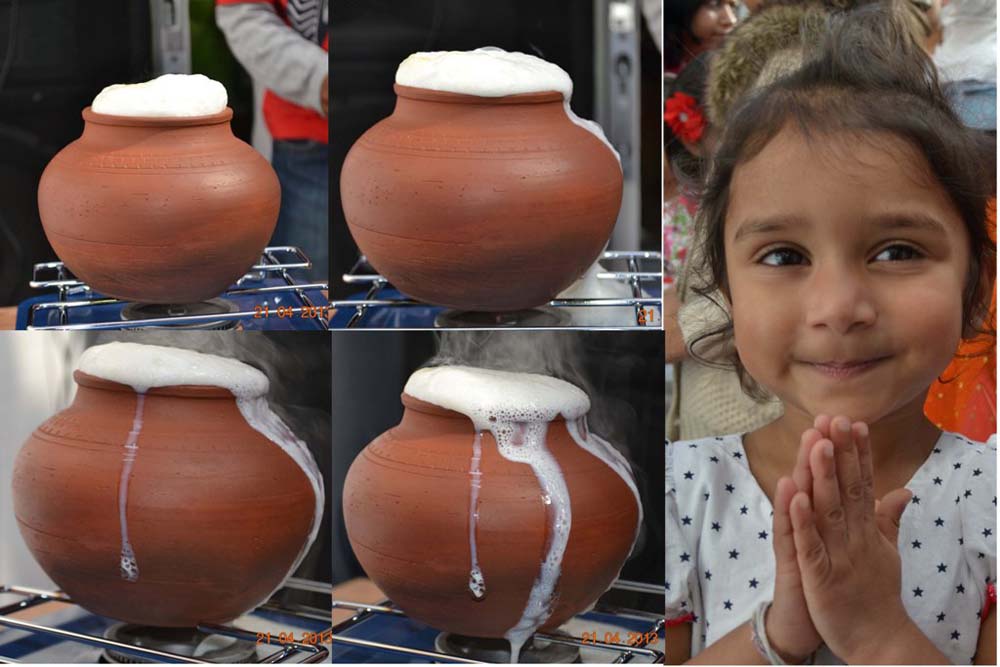 As the auspicious time draws near, traditions encourage locals to refrain from materials pursuits and pursue time with their families, religion and history. A game of carrom with your well versed grandparents, would also suffice as a way to accomplish those traditions. The unmistakable rumble of firecrackers would often beckon in after the arrival of the New Year at which member of the family would light oil lamps, and begin cooking the traditional ‘Avurudhu’ meals. If you were lucky enough to delegate the task of helping your mother to grate coconuts, you’d probably be relaxing outside and preparing the brick stove to boil a pot of milk to mark the arrival of peace and happiness.
As the auspicious time draws near, traditions encourage locals to refrain from materials pursuits and pursue time with their families, religion and history. A game of carrom with your well versed grandparents, would also suffice as a way to accomplish those traditions. The unmistakable rumble of firecrackers would often beckon in after the arrival of the New Year at which member of the family would light oil lamps, and begin cooking the traditional ‘Avurudhu’ meals. If you were lucky enough to delegate the task of helping your mother to grate coconuts, you’d probably be relaxing outside and preparing the brick stove to boil a pot of milk to mark the arrival of peace and happiness. Kiri bath (milk rice) remains the staple of the table across the island and it is often accompanied by a jar of honey, a plate of jaggery and lunumiris (a spicy sambal paste). Besides burning and soothing your tongue with these delicacies, the table also offers a wide variety of sweet and savory items ranging from kokis (a crisp and light decorated ring from heaven), kavum (a small oil cake), Aluwa (a sweet flour, treacle and cashew based sweet), and boring bananas. Once you’ve had your fill and regret stuffing yourself too early with kiri bath, you pay respect to your elders with a bundle of bo leaves. If you are fortunate enough, they may return the favor with a great piece of life advice instead of an envelope of cash.
Kiri bath (milk rice) remains the staple of the table across the island and it is often accompanied by a jar of honey, a plate of jaggery and lunumiris (a spicy sambal paste). Besides burning and soothing your tongue with these delicacies, the table also offers a wide variety of sweet and savory items ranging from kokis (a crisp and light decorated ring from heaven), kavum (a small oil cake), Aluwa (a sweet flour, treacle and cashew based sweet), and boring bananas. Once you’ve had your fill and regret stuffing yourself too early with kiri bath, you pay respect to your elders with a bundle of bo leaves. If you are fortunate enough, they may return the favor with a great piece of life advice instead of an envelope of cash.
 Once you’ve happily digested everything you may often find yourself gathering with a couple of friends and cousins to take part in a multitude of traditional ‘Avurudhu’ games. Kotta Pora (pillow fight, yes but much more fun because you’re on pole), greased pole climbing, Kana mutti bindima (The Sri Lankan version of the Mexican piñata) and even an embarrassing Avurudhu Kumari pageant. All in all, the day is full of excitement and good fun.
Once you’ve happily digested everything you may often find yourself gathering with a couple of friends and cousins to take part in a multitude of traditional ‘Avurudhu’ games. Kotta Pora (pillow fight, yes but much more fun because you’re on pole), greased pole climbing, Kana mutti bindima (The Sri Lankan version of the Mexican piñata) and even an embarrassing Avurudhu Kumari pageant. All in all, the day is full of excitement and good fun.
This year, the New Year brings in a time for cultural and religious harmony. It highlights how far we’ve come as a multicultural society and propels us further into a future embraced with peace, love and happiness. Although, our national cricket team couldn’t make it past the semi-finals of the World Cup, they continue to bring us a message of hope and courage. As the Sri Lankan Cricket Captain, Sangakkara, once said, “I am Tamil, Sinhalese, Muslim and Burgher. I am a Buddhist, a Hindu, a follower of Islam and Christianity. I am today, and always, proudly SrI Lankan”. Suba Aluth Avurudhak!
Gems & Public Policy March 28 2016
The Sri Lankan gem industry has been able to maintain a remarkable record in sustainable mining and local empowerment. This has largely been due to sound public policy with regard to the issuance of gem licenses and a system of wealth sharing that distributes prosperity equitably among the stakeholders responsible for uncovering earth’s finest gemstones.

Techniques used to mine for gems can be destructive to the environment if it is not carefully managed. Fortunately, the government of Sri Lanka keeps a close eye on every gem mining activity in order to ensure the protection of the local environment and the livelihoods of the local population. One such example is that the license to operate is restricted to ensure that a local party always has a majority standing in the project. This helps to disincentivize large scale machine boring processes financed by foreign corporations that may not have a vested interest in the conservation of the local land. Although the development of technology and the inflow of investment is limited by this policy, the concern for the long term impacts of unsustainable mining overweighed the benefits of fast economic development. In my perspective, this licensing enforcement was indeed a bold and daring move by public officials despite the pressure brought on by large multinational corporations. This policy has helped contain any uncontrolled growth in gem mines and preserved a large land mass from wide scale soil extraction and erosion.
In an era where much regulation is often deemed bureaucratic and inefficient, the policies put forward to maximize the development of rural areas through an intricate profit sharing scheme is indeed astounding. Under Sri Lankan law, the parties involved in mining gems are entitled to a proportion of the revenues earned by the sale of the uncovered gemstones. In a simple scenario, the miner, the land owner, the contractor and the gem merchant may each choose to earn 25% of the wholesale market price for the quality of gems mined. This is in stark contrast to many decades ago, where gem merchants often pay miniscule fixed payments, which were agreed upon before mining, to powerless rural land owners and miners. With enforced equitable margins for these less influential parties, rural development has seen an up surge in recent years. With an increased level of prosperity, these rural areas have now gotten better and more reliable access to electricity through investments in solar panels and better power transmission infrastructure. Furthermore, the higher levels of income have boosted access to better quality education and have consequentially increased literacy rates whilst lowering incidences of petty crime.
Sustainability is a key component of the Sri Lankan gem industry and it continues to evolve and develop as time progresses. The establishment of these public policies have helped generate better income distribution and wealth generation in rural economies and have sparked a greater movement toward fair trade. The benefits these policies bring toward sustainable mining and local empowerment are substantial and will lead the way to whole new line up of ethical and good business practices within the industry.
J.P. Morgan's Collection March 14 2016
John Pierpont Morgan is most famous as the greatest financier known to the history of the United States. Operating economic powerhouses and possessing influential positions in the development of modern America, J.P. Morgan was indeed a titan of the ages that impressed many by his financial and business acumen. Interestingly, he was also one of the world’s greatest gemstone collectors and the beauties he amassed were second to none.
Born in 1837, J.P. Morgan continued the work of his father as a n international banker and went on to dominate the realm of finance and economics. In addition to creating the JP Morgan company, he was also instrumental to the birth of the General Electric Company and the United States Steel Corporation. His economic power enabled him to integrate a vast network of railroads in America to promote interstate trade and was even called upon by the U.S. President to oversee America’s gold reserves at a time of financial crisis.
n international banker and went on to dominate the realm of finance and economics. In addition to creating the JP Morgan company, he was also instrumental to the birth of the General Electric Company and the United States Steel Corporation. His economic power enabled him to integrate a vast network of railroads in America to promote interstate trade and was even called upon by the U.S. President to oversee America’s gold reserves at a time of financial crisis.
His relevance to the gem industry came swiftly as he exhibited a collection of over 1000 pieces of precious gemstones at the 1889 World’s Fair in Paris. Exquisitely orchestrated with the help of George F. Kunz, a gemologist at the Tiffany & Co., this collection managed to win two golden awards and gained attention from dealers and scholars from all corners of the globe. With a passion to collect the world’s finest and rarest gemstones, J.P. Morgan paired up with another industrial behemoth, Clarence S. Bement, to set up another exhibition with over 12,000 specimens.
Much of these exotic and precious gemstones are now housed in the American Museum of Natural History in New York and are indeed a sight to see. The allure of these gemstones have attracted the admiration of many rich and powerful as they continue to learn and understand all its intricacies bound to last a lifetime.
Gemstones & The Invisible Hand March 06 2016
Buying your first gemstone jewelry can be an exciting and daunting task. With so many nuances to take into consideration, the choice of a lush blue sapphire surrounded by sparkling round diamonds can become mesmerizing and over whelming. One factor that is almost always a concern is why are they so darned expensive? This blog hopes to bring some clarity into the realm of gemstone prices and give you a better understanding how what makes that shimmering jewel so special.
According to the International Colored Gemstone Association, the prices for exquisite, top quality sapphires have risen by over forty percent over the last couple of years. Gemstone dealers may now require prices exceeding $150,000 per carat when it only fetched about $92,000 in 2009. This upsurge in prices for gemstones have been highlighted by the contemporary celebrity endorsements which have showered a great deal of glamor and grace to the colored gemstone market. For example, the blue sapphire witnessed a phenomenal increase in value as Prince William proposed to Kate Middleton with a stunning blue sapphire and diamond engagement ring. The ‘Middleton Effect’ as it has come to be known has had a strong impact on the overall gemstone market.
The growth in value for sapphires and others colored gemstones are buttressed further by the rapidly growing demand from fast developing nations such as China and India. Their cultures and histories have long held colored gemstones as icons of wealth, good fortune and prosperity. As the rich from Shanghai to Mumbai parade their glistening gold and shimmering sapphires, the underlying pries for these gemstones slowly but surely creep up to match their rising incomes and lavish lifestyles. Demand has also risen largely by diversifying investments pouring in from the West. In troubled economic times, many investors seek shelter in tangible sources of value as a form of economic security. Companies such as RareSource are now being asked by their wealthy clients to hedge portions of their portfolios with gold and gemstones from mines as opposed to risky paper backed securities.
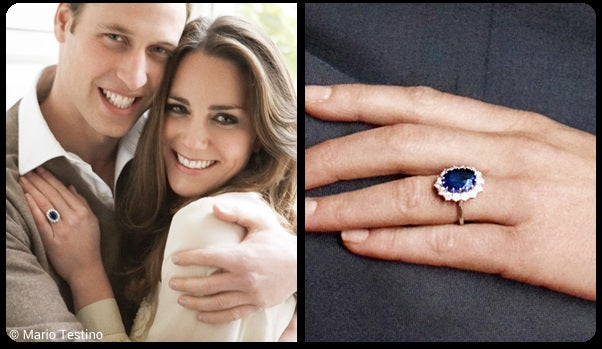
Another contributing factor lies within supply shortages. Unlike the artificial mechanisms to create supply constraints in the diamond industry, shortages in colored gemstones such as sapphires and rubies exist though genuine market imbalances such as political interference and poor infrastructure. In addition, finding high quality colored gemstones is extremely difficult even in the best of circumstances. The processes used in mining for the gems are usually much smaller in scale than the those of large diamond miners and hence when coupled with dysfunctional infrastructure such as intermittent electricity outages and politics banning international trade (the US banned the import of rubies from junta-ruled Myanmar in 2008), the supply can become severely limited. Such shortages can further propagate a rapid upsurge in prices for valuable colored gemstones.
The invisible hand of demand and supply play an intricate role in setting the prices of these exquisite gemstones. Hopefully, now you know a little more about the state of prices for gemstones and feel more comfortable whilst you browse through collections to find the perfect sapphire. The recent increase in value may continue on its run or may fall but at least a sapphire can be worn to a date unlike a worthless share certificate.
Padparadscha: A Marriage of Sunsets & Lotus Flowers February 20 2016
Sapphires are some of the finest colored gemstones in the world. With a growing trend for jewelry with a highlight for personality, sapphires serve as an ideal candidate for a wide variety of rings, pendants and bracelets. One particular sapphire, that captures traits of rarity and natural elegance is the padparadscha. Adored by gem connoisseurs, this sapphire has continued to stun audiences across the globe with its unique color and extreme rarity.
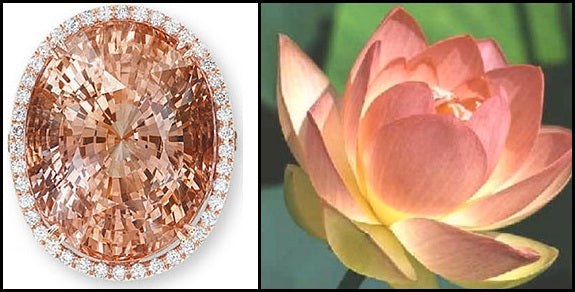
The name, padparadscha, is derived from the Sanskrit word referring to the lotus blossom, which incidentally is the national flower of Sri Lanka. However, its color is more of a marriage between the color of the sunset and the lotus blossom as it features a hue that has not yet been uniformly decided by the gem society but lies in a vivid spectrum between pink and orange. Essentially, this gemstone features a lovely light pinkish-orange salmon color that has been treasured by collectors, dealers and clients for many generations.
The padparadscha is often prized for its light hue and high clarity. However, this means that the inclusions within the crystalline structure are often made visible. Due to its rarity, finding one that has few to no inclusions will generally command a substantial price (high end padparadschas may reach up to $30,000/carat) that is well worth its representation of unique beauty. Furthermore, these gemstones are often cut to preserve the color and utilize as much of the material as possible as they tend to be in short supply throughout the global market. As a result, the padparadscha has gotten a reputation of being received in unusual and asymmetrical shapes.
For many centuries, Sri Lanka has been the finest and only source of these incredibly rare padparadschas. Despite, several other geographical locations such as Madagascar and Tanzania claiming similar gemstones, they often are priced at a discount and do not feature the same elusive hue offered by those of Sri Lankan origin. For example, it has been reported that these gems from Madagascar tend to be identified by gem experts as more pink and hence less rare than their Sri Lankan counterparts.
Padparadschas are prized for its elusivity and special color and serve as immaculate centerpieces for jewelry. Getting your hands on one of these gemstones would truly be an incredible opportunity.
King Kashyapa February 07 2016
Growing up in Sri Lanka, we often heard of lore dating back to the age of ancient kings who ruled over the citadel of 'Sigiriya'. Once such tale cusped the savagery and temperament of King Kashyapa. It was said that one morning, a peasant had discovered a lush blue gemstone and had brought it to the feet of this crazed king to spare his life and those of his young daughters. The insolent King noticed little of this poor man but once he caught the glimmer of this stunning blue gem under the glaring red sun, he was stunned with awe and admiration. King Kashyapa held this wonder on the palms of his hands, enamored by its intense cornflower blue hue, and placed it on a golden pedestal beside his throne. He ordered his guard to behead anyone who would lay his eyes on this wonder. That afternoon, after a long and tiresome wild boar hunt in the dense forests, he returned to his throne to rejuvenate his senses. Lo and behold, the gem had been replaced. The King was furious. The guards insisted that they did not see anyone enter the throne room except his Queen and children. His temper inundated him, as he rampaged across the entire palace, killing his offspring, his wife and the guards who failed him. He ordered the peasant who offered the gem to the palace and told him of the theft that had occurred. The peasant trembled in fear of the King’s anger and said,’ O’ dear King. This gem has not been replaced. Come to the light and witness the change and the fate that has been brought upon you!’
Color changing sapphires are indeed a rare breed. However, they have helped spread a message across many generations highlighting the importance of stabilizing one’s mind and emotions. Witnessing these gemstones today may not be as dramatic as they once were in Sri Lankan lore but they are indeed a spectacular sight. The most common shifts in color involve the change from a lush blue to a violet-purple under different lighting conditions. Unfortunately for King Kashyapa, it was the dimmer light of the evening sun that created this ‘new’ gemstone but unlike it, his family will not return to him at the dawn of the next day.
A better understanding of the scientific principles behind optical transmission gives us a much clearer view of why this gemstone is capable of changing colors. The cause of this change involves the presence of two light transmission windows in exceptionally rare sapphires. For example, a blue sapphire appears blue because it is capable of absorbing all of the frequencies of light except blue. However, if these sapphires absorb all frequencies of light except blue and purple, it will appear blue in light that is rich in blue wavelengths and purple in light that is rich in purple wavelengths. The morning sun, as opposed to the evening sun, is richer in blue wavelengths than it is in purple wavelengths. Hence these sapphires will tend to appear with a blue hue in the morning and a violet-purple hue in the evening.
The story of King Kashyapa is unfortunate and saddening. However, it is applicable for us all in modern times. We must not let our emotions and temperament get the better of us. Life is a series of ups and downs but being able to mediate our responses to them will help us embrace the good moments and overcome the bad.
Ratnapura: The City of Gems January 31 2016
In the southwestern part of an island nation, Sri Lanka, lies the famed city, Ratnapura. Derived from an ancient Sanskrit language meaning the ‘City of Gems’, its name heralds the fortune it amasses for the local population. The people of Ratnapura come from diverse backgrounds but remain coalesced by the constant supply of rich culture, natural wonder, mystical history and vibrant trade.
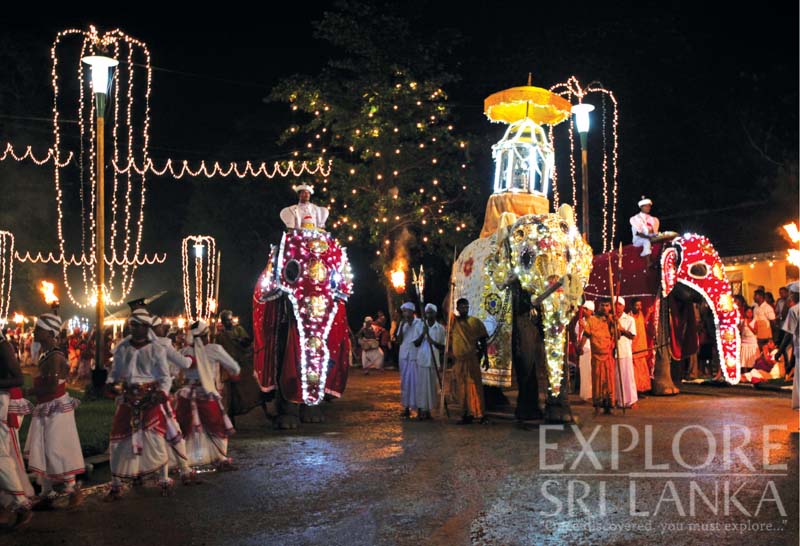
With over 52,000 people consisting of Buddhists, Hindus, Christians and Muslims, Ratnapura has seen religion develop a strong and deep culture within its community. Places of worship are abundant and promote a sense of care and compassion for all they can reach. The Maha Saman Devalaya (a shrine dedicated to the deity, Saman, who is considered to be the guardian of Ratnapura), the Siva temple and St. Luke’s Church are prominent locations for communal gatherings and religious ceremonies. A notable ritual of the region involves the annual pilgrimage to the mountain, Sri Pada.
 Sri Pada is a 2243-meter-high peak that has gained widespread acclamation for its natural beauty and religious importance. It is believed that Adam took shelter at the foothills of this peak when he was banished from Garden of Eden. It also houses the sacred footprint of Lord Buddha when he arrived in Sri Lanka. The significance of this peak across religions grant it a mystical allure and have continued to impress travelers from across the world by its unique view of the rising sun across the plains of Ratnapura.
Sri Pada is a 2243-meter-high peak that has gained widespread acclamation for its natural beauty and religious importance. It is believed that Adam took shelter at the foothills of this peak when he was banished from Garden of Eden. It also houses the sacred footprint of Lord Buddha when he arrived in Sri Lanka. The significance of this peak across religions grant it a mystical allure and have continued to impress travelers from across the world by its unique view of the rising sun across the plains of Ratnapura.
The geography of Ratnapura also features the ‘Kalu’ river and numerous waterfalls. The rich alluvial deposits of this river scatter the world’s finest gemstones throughout this city. Thousands of years of crystallization and erosion have blessed Ratnapura an abundance of rubies, sapphires, garnets and topaz. The local traders partner with landowners and community developers to mine these invaluable gems and have set up a flourishing industry that has generated a strong and sustained growth in jobs, infrastructure and regional development.
 The ‘Kalu’ river also generates a wide array of agricultural farming in the city because of the incredibly fertile soil surrounding it. Rice cultivation is by far the most prevalent form of farming in the area but there are also households growing delicious mangos, bananas and papayas. There has also been a recent surge in tea plantations which are capable of brewing a bold and flavorful cup unique to the nation’s multi-generational tea industry.
The ‘Kalu’ river also generates a wide array of agricultural farming in the city because of the incredibly fertile soil surrounding it. Rice cultivation is by far the most prevalent form of farming in the area but there are also households growing delicious mangos, bananas and papayas. There has also been a recent surge in tea plantations which are capable of brewing a bold and flavorful cup unique to the nation’s multi-generational tea industry.
The evolution of each industry has gradually allowed the skillset of the local population to improve. 3D CAD designing for jewelry and laboratory tests for the safe cultivation of tea are some of the emerging areas for spearheading the growth in the job development. Many more are likely to follow as this city continues to bless its people in the form of professional and regional development.
Of Flame and Crystal January 23 2016
Gemologists around the world have carefully developed an assortment of techniques to enhance the color and clarity of natural sapphires. Some have been used for millennia whilst others have been introduced within the last few decades. It is commonplace for a sapphire gemstone to have received an enhancing treatment in order for it to catch the discerning eye of traders and consumers alike. This blog will feature four such treatments and capture some of the controversies involved in the newer techniques.

One of the most common and oldest techniques to treat a sapphire is through heat. The process involves a brief encounter of the sapphire in a blazing hot furnace reaching temperatures ranging from 4,000 degrees Celsius to 17,000 degrees Celsius. The heat helps to dissolve the rutile imperfections within the crystal structure amongst other changes and improves the overall saturation of the gemstone. Although heat treated sapphires account for the vast majority of sapphire sales, a very strong niche exists for the allure of stunning untreated sapphires as a result of its extreme rarity.
A recent technique involves a chemical flux treatment. It is often minute fractures and cavities within the corundum crystal that gives rise to an impairment in clarity and durability. In order to mend this, a sapphire can be heated once again but with the presence of a chemical flux that will melt and fill these gaps. Once cooled, it may solidify into a transparent structure within the crystal (fracture filling) or promote re-crystallization within the cavities (flux healing). This treatment rarely exists within the sapphire industry but has been widely reported throughout the ruby trade. Controversies involved in this treatment complain that the flux basically holds together poor quality gemstones through a transparent paste and makes it increasingly brittle to be able to not even withstand routine jewelry cleaning and polishing.
The most controversial treatment involves diffusion with agents such as Beryllium and Titanium. In this technique, the sapphire is heated close to its melting point and then introduced to these coloring agents. The alien element diffuses uniformly around the crystal and creates an illusion of excellent saturation and tone. The issue is that this coloring agent creates only a layer within the gemstone and the true nature can be revealed once polished or unfortunately (or fortunately in this case) chipped. Beryllium helps to color a sapphire in a lush orange whilst Titanium generates a deep blue hue. The relative color changes can be easily detected by a trained jeweler and is often heavily discounted due to the façade it pulls to mask a sub-par sapphire.
Although rare in occurrence, sapphires can also be subject to carefully controlled irradiation to generate brighter yellows and darker oranges. Once again, a trained jeweler has an array of tests to identify this treatment. The issue is that the color often fades upon exposure to bright light or high temperatures. Therefore, this treatment is often temporary and can be easily detected using a brief encounter with a strong showcase lamp.
The processes of heat, chemical flux, diffusion and irradiation have been used to treat sapphires in a wide array of circumstances. However, it is often the time tested technique that continues to prevail within the industry. As a result, the heat treatment of sapphires is the widely accepted technique used to enhance the sapphire’s allure to the consumer.
Color Caveats January 17 2016
The color of a sapphire can be a difficult feature to assess. Even professionals may have varying judgments on the true color of a given sapphire. However, through decades of experience and expertise, gemologists have been able to formulate an objective means of determining the all-important color of a sapphire through its hue, tone and saturation.

The first character that determines the true color of a sapphire is its hue. The first impression or the basic color given by this gemstone is what it means by its ‘hue’. For example, at face value a sapphire may possess more than one color. A sapphire mounted on an 18K white gold engagement ring may have tints of green or even violet. This ‘greenish blue’ or ‘violetish blue’ can have a significant impact on the value and beauty of the gemstone but one must always consider other aspects of the sapphire in tandem with its hue.
The second factor involves the tone of the sapphire you are admiring. This refers to how dark or light it appears under controlled lighting conditions. Once again, the preferred tone often varied from each unique sapphire but more often than not, it is a medium to medium-dark tone that excels all others. A tone that appears lighter would be characterized as ‘un-embodied’ and one that reaches very dark tone would be negatively connoted as ‘inky’.
The final and most important character determining the color of a sapphire is it saturation. The intensity of the color plays a vital role in determining its value and aesthetics and it is often blemished by the inclusion of ‘saturation modifiers’. These appear as gray tints in blue, green and violet sapphires and brown tints in yellow, red and orange sapphires. Ideally, the best sapphires have an intense and strong saturation which is not diluted by the presence of ‘saturation modifiers’.
These three factors are the yardsticks upon which sapphires are graded and valued for color but there are also many other factors that can have a discernible impact on a sapphire’s color. For example, the presence of inclusions such as 'rutile' needles can disperse reflected light more profusely and even the cut of the sapphire itself could be adjusted to minimize color zoning and maximize color definition.
Sapphires are often praised for their rich colors and being able to assess this attribute using the features of hue, tone and saturation will aid your search in finding the perfect sapphire. However, one must keep in mind that these factors fall into a whole range of characters that determine the value of a gemstone. Color is important but it has no exclusive say in what determines a ‘great sapphire’. Just like us, a single trait cannot define a sapphire but it sure can diminish one.
Don't forget to go through our "sapphire buyer guide". We are sure it will help you make a more informed decision about investing in natural Ceylon sapphire jewelry!
Source: http://www.thenaturalsapphirecompany.com/education/judging-sapphire-quality/judging-sapphire-color/
The Star of Adam: World's Largest Blue Star Sapphire January 05 2016
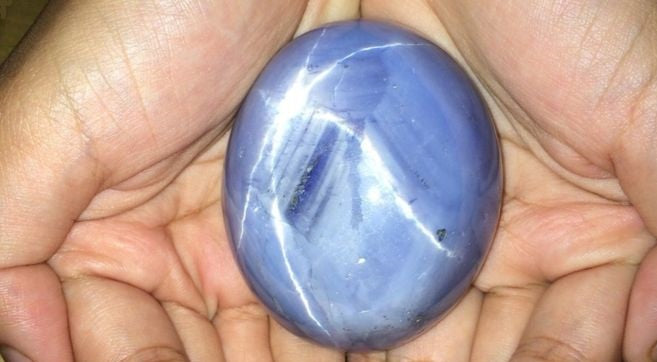
The unearthing of the world’s largest blue star sapphire is indeed exciting news for all of us in the gem industry. The fact that it was mined in the city of Ratnapura, ‘the City of Gems’ in Sri Lanka makes it that much more exhilarating as it goes to show how resourceful this beautiful island nation is.
Sri Lanka continues to be one of the world’s rarest places being blessed by these large and natural gemstones.
This finding is exemplary of Sri Lanka’s continuing success in presenting the finest gems the world has ever seen and is bound to attract an increasing amount of interest and investment to protect and sustain this precious industry.
This sapphire has been named, ‘the Star of Adam’, by its anonymous owner and has an astounding weight of 1,404.49 carats. The name originated from a local belief that Adam descended to Sri Lanka (Ceylon) after he was sent away from the Garden of Eden. The mountain in which he rested is claimed to be Adam’s Peak which is located near the northeastern section of the Ratnapura district.
An extensive analysis conducted by the Gemological Institute of Colombo has confirmed that this sapphire is indeed the largest blue star sapphire in the world and has given an intrinsic value of at least $100 million.
The owner suggests that its value could soar up to $175 million if it is auctioned. Either way, this gemstone, which can be cupped with two hands, is of incredible value both monetarily and nationally given the pride and awe it gives to all Sri Lankan nationals.
The Star of Adam has a lush blue hue and is marked with 6 stunning rays created by a natural phenomenon known as optical asterism. It was considered more of an ‘exhibition piece’ than jewelry by its current owner but its current state and future endeavors remain beyond the limelight.
Star sapphires have continued to spark awe in the eyes of many for generations, and this gemstone will continue to lay down its legacy for many more to come.
Star Sapphires: Nature's Perfect Imperfection December 22 2015
Star sapphires are indeed a spectacular sight.
Ranging from a simple 4 point ray to a wildly complex and rare 12 point ray, these sapphires have astounded admirers for many generations.
Viewed best under a single source light such as the sun, a star sapphire, will parade its beauty through a natural phenomenon known as optical asterism.
As an untreated rough, a sapphire will often possess inclusions within its crystalline structure. These inclusions are often impurities such as titanium dioxide (rutile) which can appear in the form of needles or thin tubes.
Nature rolls the dice and sometimes, these inclusions line up in a parallel fashion perpendicular to the axis of the crystal. These tiny inclusions then concentrate their reflections into a single band of light giving the optical characteristic of a cat’s eye. By having inclusions lined perpendicular to multiple axes, the sapphire crystal can illuminate as many as 12 rays to form a beautiful star configuration. This effect, known as asterism, gives birth to the natural wonder of star sapphires which can be accentuated by shaping the sapphire in to a high domed cabochon with little to no heat treatment.
In the case for star sapphires, they are best worn as rings or bracelets as o pposed to brooches, earrings or pendants. The orientation of rings and bracelets when viewed on our hands allow light to penetrate perpendicular to the base of the crystal which emphasizes the star effect. When choosing the perfect star sapphire, the elements of color, clarity, cut and carats still play a vital role in determining its value even though this unusual star effect is in itself an amazing phenomenon.
pposed to brooches, earrings or pendants. The orientation of rings and bracelets when viewed on our hands allow light to penetrate perpendicular to the base of the crystal which emphasizes the star effect. When choosing the perfect star sapphire, the elements of color, clarity, cut and carats still play a vital role in determining its value even though this unusual star effect is in itself an amazing phenomenon.
Star sapphires are a rare breed. They require an assortment of variables to align at the right moment to reveal its astounding beauty. So if you do get your hands on one, you’ll be sure to make a statement of natural beauty as a result of perfect imperfections.
Gem Tales December 07 2015 1 Comment
What I love about sapphire jewelry is its ability to tell stories of its past lives. These natural gemstones last for many generations and with that come a rich history that would captivate any soul. In 2013, in the outskirts of France, an engagement ring was sold by the Onsenat auction house for 730,000 Euros ($1.17 million). The price it reached was almost 40 times what the experts at the auction house estimated and this premium was no surprise given its prominence in the hands of Napoleon Bonaparte and Josephine (Rose Tascher de la Pagerie as she was known back then).
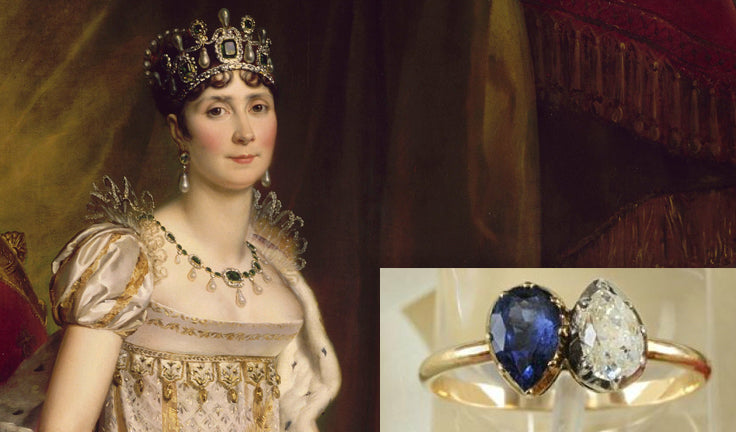
The story of their encounter, love and tragedy has been inextricably linked to the 18th century gold ring featured in a “toi et moi” (“You and Me”) setting with opposing tear shaped gemstones: a lush blue sapphire and a sparkling diamond. The bidders came from across the world and remained anonymous as they reached into their deep pockets with 10,000 Euros at a time to secure a piece of remarkable history.
Napoleon was only a young officer when he first met Josephine and he fell in love with her immediately. She was the widow of a French aristocrat who had two children, and as they acquainted each other for several months, their love grew into their marriage on March 9th in 1796. Excerpts from his memoirs portray a wild love as they longed for each other when Napoleon departed to lead the French army against the invasion of Italy.
Napoleon says,” Since I left you, I have been constantly depressed. My happiness is to be near you. Incessantly I live over in my memory your caress, your tears, and your affectionate solicitude.” He continued, “How happy would I be if I could assist you in your undressing, the little firm white breast, the adorable face, the hair tied up in a scarf a la creole.”
Unfortunately, Josephine had other ideas while Napoleon fought in the front lines of the war. Her affair with a French lieutenant did not go unnoticed as Napoleon completely changed his writing to reflect his anger and frustration. One letter said, “I don’t love you. Not at all; on the contrary, I detest you. You’re a naughty, gawky, foolish slut”.
The ring that he gave Josephine lasted through this turmoil and was passed down her family until it was sold in 2013 in the Onsenat auction house. The contrast that was depicted in this ring embodies the tragic love that Napoleon had Josephine which turned from a lush rich emotion to a hollow and cold disgust.
No matter what the story is, each gemstone continues to give us an insight into its interesting past. You have the power to make your own and you can be assured to have it retold many generations after you owning your own signature piece of heirloom jewelry.
The Facts On Facets November 30 2015
Adorning a gemstone comes naturally to many. We become entranced by its rich color and its glimmering facets as wear it on our hands and around our necks. Our beauty illuminates through its natural form as we show the world the coupled existence between lady and gem. Being as much a part of ourselves, we should identify everything that makes these gems as beautiful as they are.
In particular, the facets of a gem can greatly define whether it shines elegantly or remains dim perpetually. The facets of any gemstone are borne out of precise cuts which can be appraised using the 5 P’s: points, proportions, polish, positioning and performance.
Points refer to the precision of each cut producing a single facet on the gemstone. Ideally each cut should be even and uniform so that the edges and intersection are well aligned and symmetric. Achieving this ideal requires great craftsmanship and patience as the master lapidarists make highly accurate adjustments to the height, angle and index of the gem position when performing each cut. It is therefore no wonder that the saying, ‘cut and look…cut and look’, is a time honored reality for many of these highly skilled lapidarists.
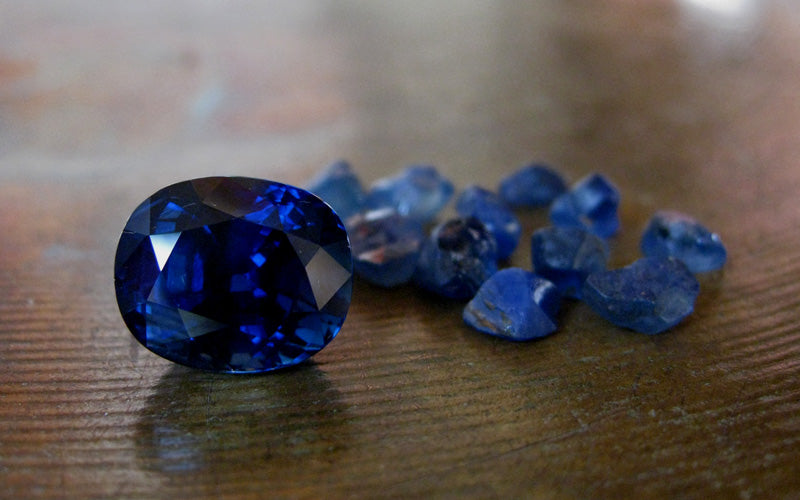 Proportions refer to the size of the gemstone with respect to each of its components. The most suitable cut for any gemstone should encompass a ratio where 1/3rd of the gemstone consists of the crown (the top part) and 2/3rd of the gemstone consists of the pavilion (the bottom part). This golden ratio ensures that the refraction and reflection of light through the gemstone remains even given that all other aspects are followed precisely.
Proportions refer to the size of the gemstone with respect to each of its components. The most suitable cut for any gemstone should encompass a ratio where 1/3rd of the gemstone consists of the crown (the top part) and 2/3rd of the gemstone consists of the pavilion (the bottom part). This golden ratio ensures that the refraction and reflection of light through the gemstone remains even given that all other aspects are followed precisely.
Polish is mere integrative component of points and proportions. Achieving these two factors will ensure that this gemstone grants its bearer a wonderful polish. By allowing light to follow symmetric paths in a well-proportioned gemstone, it will naturally illuminate a sincere polish of master craftsmanship and hence would be a clear indicator that the gemstone has received a precise cut.
Positioning is another skill that requires decades of training and mastery to perfect. A rough gemstone will almost always have a few inclusions and imperfections within it but it is the trained eye of the master lapidarist to determine exactly what portion of that rough can be utilized to produce a flawless masterpiece. By cutting in exact positions within the rough, the lapidarist can manipulate the flow of light through the gemstone to hide, minimize and even eliminate certain inclusions and therefore this component plays a significant role in creating a gemstone worthy of timeless appreciation.
The final factor, performance, is another integrative component which takes in to account of all the other pieces that make a precise cut. If all factors have perfectly aligned with each other, the gemstone will be able to perform optically even when tilted or shifted from its normal orientation. It will be able to reflect and refract the maximum amount of light through its structure so that it appears as if it is glimmering and dancing in the many shades of its lush color.
You now have a bigger toolkit to evaluate the next gemstone you purchase. The points, proportions, polish, positioning and performance of a gemstone play an integral role in determining its beauty and ability to illuminate your own. The skill, mastery and patience possessed by the craftsmen who form these gemstones are indeed remarkable and it surely is surfaced by generations of people who continue to wear and embrace this natural gift.
Care for Karats? October 30 2015
The economic value of gold has been leveraged by society for centuries. It’s been used as a hedge against inflation, it once pegged the US dollar in the ‘Gold Standard’ and it’s still being used by entire economies as a security against turmoil. However, its aesthetic value has transcended countless generations. Its representation of wealth and prosperity has eternalized its natural glamor since our early ancestors discovered the ability to melt and mold it into a variety of shapes and sizes. The jewelry industry grew largely from incorporating this incredible precious metal into their designs and therefore it is no surprise that it is an essential component of their collections. Understanding the different types of gold available can, therefore, play an important role in choosing the right gold jewelry for your own collection.
One of the biggest differentiating factors involve the purity of the gold, as measured by the unit, Karats. Its scale runs from 24K (100% pure gold) to 0K (0% pure gold). In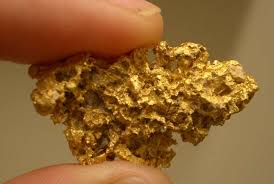 today’s market, even 24K gold is often only 99.95% pure gold despite its nomenclature as it is practically infeasible to manufacture such high purity outside a laboratory.
today’s market, even 24K gold is often only 99.95% pure gold despite its nomenclature as it is practically infeasible to manufacture such high purity outside a laboratory.
For example, gold bullion, exists as 24K but is practically only about 99.95% pure gold. In addition, to gold bullion, certain jewelers design 24K gold jewelry. However, these designs (often elaborate and detailed) are intended for very special occasions as the metal itself is very delicate at that stage of purity. Regular use is very likely to distort its original appearance and hence tarnish its complete beauty.
22K (91.6%) gold jewelry on the other hand have slightly more strength but are mostly used for plain designs such as necklaces and arm bands. The lustrous yellow is very appealing factor to many of the clients who purchase jewelry of this high purity. However, 22K gold is still too delicate to handle designs that incorporate precious gemstones and diamonds. In this case, the most practical and widely used measure is 18K gold (75% pure gold). Naturally, as the content of gold declines, its bright yellow luster also begins to slowly fade. This effect is largely compensated by blending in other metals such as copper (to obtain yellow/rose gold) or palladium (to obtain white gold). In the final steps of design, almost all gold jewelry are coated with a thin film of rhodium to protect the precious metal from the elements. This coating will also prevent any minor scratches and will maintain its beautiful shine for years to come.
Purchasing gold jewelry is always an exciting time and navigating the avenues of its purity in a well-informed manner will aid in your search for that perfect addition to your collection. Its value, both economically and aesthetically, is well known to us since ancient times but it sometimes can be confusing when one does not know the differences that exist in the types of gold available. Hopefully, this article gave you a better understanding of these variances and made you appreciate as to why they exist.
The Blue Giant of the Orient. October 24 2015
They are the 400 carat Blue Belle of the Orient, the 423 carat Logan Sapphire and the 466 carat Blue Giant of the Orient. In this post, I explore the largest and mysterious of them all, the Blue Giant of the Orient.
The rough that housed this incredible gem was found in 1907 in the ‘Kalu Ganga’ (black river) which serpents its way through the foothills of Adam’s Peak in the district of Ratnapura (the city of gems as it is known in 'Sinhala'-native tongue in Sri Lanka). From the point at which it was found, Messrs O. L. M. Macan Markar & Co knew that this gem was going to be something extraordinary!
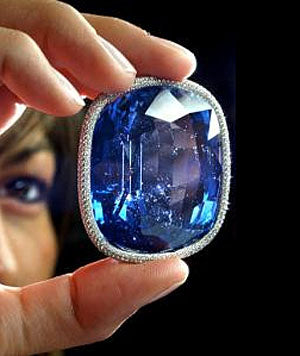 By August 23rd in 1907, the headline in the ‘Morning Leader’ a leading newspaper in Sri Lanka, ran the story of this enormous beauty. At the time it was valued at £7,000 and was bought by an anonymous American collector whose identity is still unknown. For over 90 years, this sapphire remained out of the public eye, but in 2004 it resurfaced in Christie’s Magnificent Jewels Sale in Geneva, Switzerland. Its description was erroneously given a Kashmir origin because of its prized ‘cornflower blue’ hue but the fact that Kashmir never produced a natural gem over 400 carats inextricably linked its origin back to Sri Lanka. Unfortunately, the public auction raised no bids but a private sale after the event gave an anonymous Briton the Blue Giant of Orient for $1 million.
By August 23rd in 1907, the headline in the ‘Morning Leader’ a leading newspaper in Sri Lanka, ran the story of this enormous beauty. At the time it was valued at £7,000 and was bought by an anonymous American collector whose identity is still unknown. For over 90 years, this sapphire remained out of the public eye, but in 2004 it resurfaced in Christie’s Magnificent Jewels Sale in Geneva, Switzerland. Its description was erroneously given a Kashmir origin because of its prized ‘cornflower blue’ hue but the fact that Kashmir never produced a natural gem over 400 carats inextricably linked its origin back to Sri Lanka. Unfortunately, the public auction raised no bids but a private sale after the event gave an anonymous Briton the Blue Giant of Orient for $1 million.As of today, the Blue Giant of Orient is still under private hands. Its location, its bearer and its beauty still remains known only to a privileged few. The circumstances that produced this gem are as rare as its public disclosure but we can be rest assured that it is kept safe and secure by its mystery owner. Hopefully, it won’t take another 90 years for it to be made visible to the rest of the world.
The Logan Sapphire October 09 2015
The epitome of the skill and mastery of Sri Lankan gem cutting is embodied in a gemstone known as the Logan Sapphire.
This elegant blue sapphire, which is of Sri Lankan origin, is the second largest gemstone in the world weighing in at 422.99 carats (84.6 grams) and is currently housed in the Smithsonian National Museum of Natural History in Washington D.C, USA.
The Logan sapphire was donated to this museum by Mrs. John Logan in 1960 and can be found in the gem gallery in between the Bismarck sapphire necklace and the Hall sapphire and diamond necklace.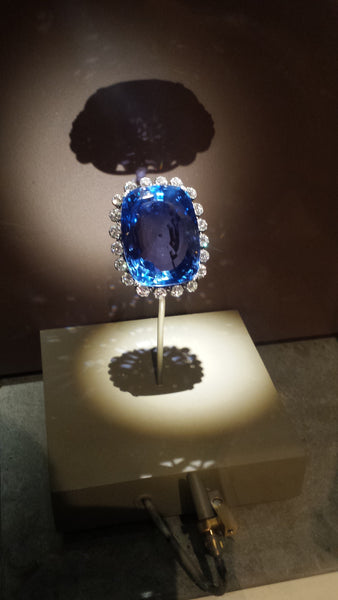 The Logan emanates a lush cornflower blue as it is set in a silver and golden brooch framed by twenty round diamonds that add a brilliant aura around it. After being examined by the Gemological Institute of America in 1997, has been declared completely natural with absolutely no heat treatment to enhance its color. In its natural state, it radiates its beauty through its flawless internal structure and perfect clarity. The master gem cutter had a clear vision of the value propagated by this incredibly rare gemstone and hence featured a precise cushion cut with a large table to allow admirers to view the flawless interior of this extraordinarily large sapphire.the Logan sapphire
The Logan emanates a lush cornflower blue as it is set in a silver and golden brooch framed by twenty round diamonds that add a brilliant aura around it. After being examined by the Gemological Institute of America in 1997, has been declared completely natural with absolutely no heat treatment to enhance its color. In its natural state, it radiates its beauty through its flawless internal structure and perfect clarity. The master gem cutter had a clear vision of the value propagated by this incredibly rare gemstone and hence featured a precise cushion cut with a large table to allow admirers to view the flawless interior of this extraordinarily large sapphire.the Logan sapphire
The entire history of this gemstone is not exactly clear. The best estimates date the mining of this precious stone to the early 19th century. After being cut by the ancient Moors of Sri Lanka, who often emphasize the ‘quantity’ aspect of gems, it was exported to Paris to be sold at a gem and jewelry auction. One notable owner who purchased this gemstone was the Guggenheim family who operated the American Smelting and Refining Company (ASARCO). It was the Robert Guggenheim that helped open the Hall of Gems and Minerals at the Smithsonian Museum but as he passed away, his wife Mrs. Logan, donated the gemstone to the museum as a tribute to her loving husband.
The Logan sapphire is indeed a masterpiece of Nature’s creations. Its journey from mine to museum has seen decades of love, compassion and dedicated craftsmanship. As it sits in the revered halls of the Smithsonian, we can be rest assured that it will continue to spark awe and admiration upon those who appreciate its natural perfection.

